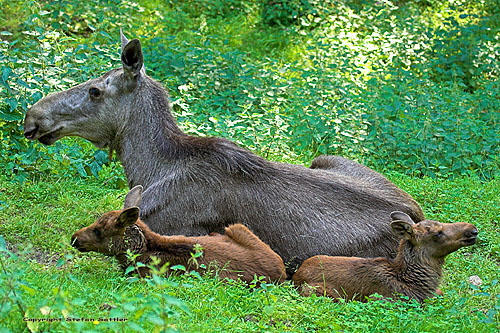Moose Species and Population
Stefan Sattler was born in April 1969 in a small town, called Forchheim (close to Nürnberg), in southern Germany in the area of Franconia, where he still lives. He began photographing when he was 10 years old and today is an accomplished amateur photographer and the creator of one of the world's most comprehensive Web sites on moose: Mooseman.de.
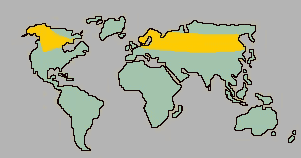
Moose can be found in forested areas with lakes or ponds, streams and swamps, i.e., moist conditions.
Coniferous and young mixed forests are their home. Snow cover in the winter up to 60-70cm can be seen as standard Moose habitat is determined by temperatures. Moose prefer zones where the summer average is around 15ºC and does not exceed 27ºC for long. The reason for this temperature dependency: They cannot sweat and they produce additional heat by fermentation in their gut.
Besides the cooling effect of water, from which moose are seldomly far away, water protects against biting insects and offers good food supply.
Moose are native in nearly all Northern forest zones:Northern Europe, Northern America, the Baltic region and Siberia as well as in the colder regions of Asia.
The habitat is limited to the South by approximately the 50th parallel and to the North by the 67th parallel.
Scientifically this is taiga, forest tundra, temperate forest and rain forest, i.e., boreal and subarctic zones.
Two main areas are perfectly related to vegetation and the content of nutrients: Flooding areas, where high levels of nutrients/minerals come into the soils; when ponds are flooded, they grow nutrient-rich aquatic vegetation. The other area is forest burnt down by forest fires. Here high levels of nutrients also are available, and young forest can emerge giving the perfect food supply for moose.
The minerals required are found in silt and loess-soils found in the northern temperate zones, which forms the main habitat of the moose. These soils, combined with usually young eco-systems, give rapid plant growth of nutrient-rich and soft plants—the perfect food for moose.
Moose stay resident if they find enough nutrition. Huge parts of the North American moose population have a home-range of between 5-40km2. Looking at their colleagues high up north with less food supply, the home-range can be up to 25-times that big! Alaskan moose have around 260 km2 in average browsing range.
In their home zone moose seem to have small areas with high utilization, likely those with a rich food supply. Other areas are only used for transit. Also the mating grounds can be those with high attendance.
Usually moose have their home-range not far away from the place they were born (provided that the food supply is adequate), normally not more than half a day-trip away. Cows have an average distance of their habitat from their place of birth of 8-16km; bulls exceed this normally.
Moose are found in higher elevations in summer time (higher than 1500m) than in winter (lower than 1000m).
All moose on Earth belong to one species (Alces alces linneaus). (For the scientific classification of the moose in general see the Species link at the bottom of this page.)
Looking further at differentiation into sub-species, a point of controversy comes up: below you find the standard classification into a variety of subspecies, as science has defined it.
But newer sources question this classification, the argument being that observed differences in moose can be explained by differences in their environment. On this reasoning are only two subspecies: for this point of view see the Environmental Classification link at the bottom of this page.
The following sub-species are defined depending on the geographical habitat and discoverers:*
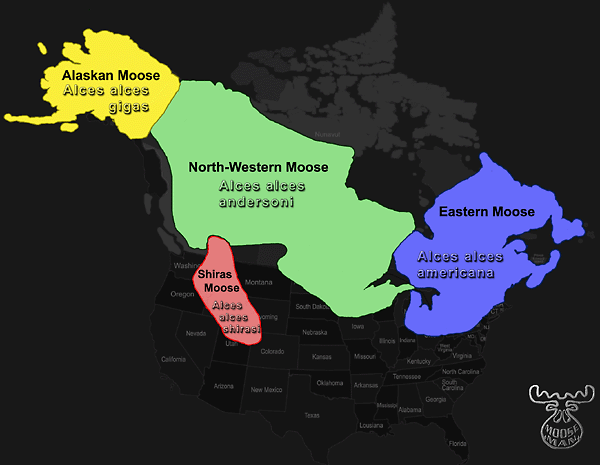
Limited to the Rocky Mountains as far south as Colorado, and to eastern states bordering Canada. Can be found nearly all over Alaska.
The population is currently still extending due to protection. With increasing numbers also the range is extending.
In general the North American moose have a more bright saddle than the European ones, with darker legs and face. The antlers have approximately double the weight of the European species with four prongs.
Approximately 1 million moose in 9 provinces and 3 territories; Provinces: Alberta, British Columbia, Manitoba, Newfoundland and Labrador, New Brunswick, Nova Scotia, Ontario, Quebec and Saskatchewan; Territories: Nunavut, Yukon and Northwest Territories.
(15 states): Alaska, Colorado, Idaho, Maine, Minnesota, Montana, New Hampshire, New York, North Dakota, Utah, Vermont, Washington, Wisconsin, Michigan and Wyoming.
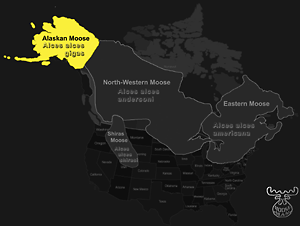
Alces alces gigas
Discoverer: Miller, 1899**
The Alaska or Yukon Moose is the biggest sub-species. Bulls can get 2.5m high at the shoulders (average 2m) and up to 3.1m long at a weight of 1000 kg. A full-grown bull with its tremendous antlers ( about 23kg, 2m wide) is the largest wild animal in North America.
This moose is black-brown with brighter back and pale brown legs. Face and nose of the cow are redish-brown, while the bull has a black nose.
The bell (throat beard) is longer than that of the European moose—it can get up to 96 cm!
It is estimated, that the moose came over the Behring bridge to Alaska 350 thousand years ago.
Population: Estimated 170,000-220,000

Alces alces andersoni
Discoverer: Peterson, 1950
Largest propagation is brownish-black and medium sized.
Population: Estimated 350,000-410,000.
Estimated population for British Columbia: 175,000.
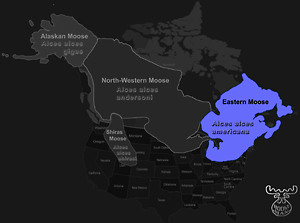
Alces alces americana
Discoverer: Clinton, 1822
Mahogany-brown in color, smallest North American subspecies.
After moose hunting was forbidden between 1935 and 1980 in Maine, the number of moose increased from 7000 in 1950 to 20,000 in 1990, a good example of how human interaction influences moose population.
Population: estimated 250,000-330,000.
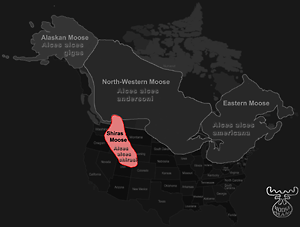
Alces alces sherasi
Discoverer: Nelson, 1914
A medium-sized sub-species with relatively wide nose-openings. The back is colored more pale/grayish compared to the other American sub-species.
Population: Estimated 25,000.
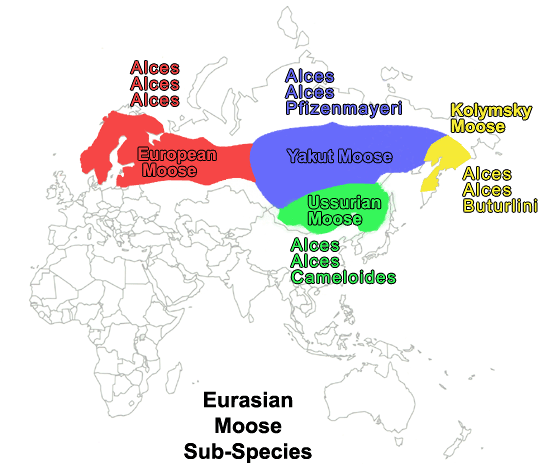
Siberia, Sweden, Norway, Baltic region.
In the European part of Russia the moose was nearly extinct in the 1920s. By protection of the moose against hunting the population has about tripled since then.
In Asia the more northern, colder areas are the main habitat for moose.
Population: about 1.5-2 million moose in 12 countries: China, Czech Republic, Estonia, Finland, Lithuania, Norway, Manchuria, Poland, Russia, Siberia, Slovakia and Sweden.
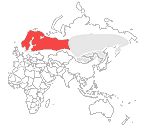
Alces alces alces
Discoverer: Carl v. Linnè, 1758
The size of this moose is somewhere in the middle, tending to relative big. The length of a bull moose is around 2.70m, the weight can be more than 500 kg. The cow weighs between 275 and 375 kg. The length of the bulls skull is between 55 and 58cm.
European moose are colored dark brown with white legs. Their antler size is broadly smaller than that of the North American moose and they have three prongs. Their saddle is dark.
Oldest discoveries of moose bones are dated to be around 100-150 thousand years old in Europe.
Population: Estimated total: 1.3 Million (from which around 700,000 are in Scandinavia)
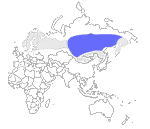
Alces alces pfizenmayeri
Discoverer: Zukowsky, 1910
This subspecies is bigger than the European moose with a length of up to 300 cm. It can gain a weight of 570-650kg with shoulder height between 225-240cm. The bulls head-length is between 59 and 62cm.
This moose's color is comparable to the European Moose, but the legs are darker and sometimes colored similar to the body. In winter you can see more grayish colors. It has usually a bigger beard than Alces alces alces.
Population: Estimated 10,000.
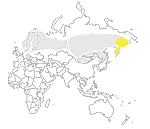
Alces alces buturlini
Discoverer: Chernyavsky/Zheleznov, 1982
Biggest specimens are found in the northern parts. Size can be as big as the Alaskan moose.
Population: No information

Alces alces cameloides
Discoverer: Milne-Edwards, 1867
This is the smallest subspecies, and rather short-legged as well with a weak build, but a comparably big head, although a little bit smaller still than that of Alces alces alces (perhaps the perfect comic moose?)
With a standard weight of around 320kg the bull can also reach 400kg at a length of 250-275cm.
Alces alces cameloides has dark fur with bright legs. Mating season starts earlier than for other sub-species.
Morphological similarities with the North American moose suggests a high level of relation. This subspecies is endangered and today protected by law.
Population: Estimated 11,000.
Alces alces caucasicus
Discoverer: N. Vereshchagin, 1955
This small subspecies (head-length 53-54cm) unfortunately became extinct in the beginning 19th century!
Population: Extinct.
______________
*Caldwell reports 7 sub-species, not including Alces alces buturlini because of the lack of population data. In addition, she questions whether it may indeed be the very same species known as the Alces alces cameloides. Both seem to inhabit the same region of Siberia.
**Source for all discoverers: Prof. Dr. W. G. Heptner and Dr. A.A. Nasimowitsch, Der Elch, Wittenberg: Verlag A. Ziemsen, 1974.
Information on this page: © Stefan Sattler

